| Listing 1 - 10 of 112 | << page >> |
Sort by
|

ISBN: 0691081123 1400881706 Year: 1972 Publisher: Princeton (N.J.) : Princeton university press,
Abstract | Keywords | Export | Availability | Bookmark
 Loading...
Loading...Choose an application
- Reference Manager
- EndNote
- RefWorks (Direct export to RefWorks)
An especially timely work, the book is an introduction to the theory of p-adic L-functions originated by Kubota and Leopoldt in 1964 as p-adic analogues of the classical L-functions of Dirichlet.Professor Iwasawa reviews the classical results on Dirichlet's L-functions and sketches a proof for some of them. Next he defines generalized Bernoulli numbers and discusses some of their fundamental properties. Continuing, he defines p-adic L-functions, proves their existence and uniqueness, and treats p-adic logarithms and p-adic regulators. He proves a formula of Leopoldt for the values of p-adic L-functions at s=1. The formula was announced in 1964, but a proof has never before been published. Finally, he discusses some applications, especially the strong relationship with cyclotomic fields.
Number theory --- 511.6 --- Algebraic number theory --- L-functions --- Functions, L --- -Number theory --- Algebraic number fields --- Algebraic number theory. --- L-functions. --- 511.6 Algebraic number fields --- -511.6 Algebraic number fields --- Abelian extension. --- Absolute value. --- Algebraic closure. --- Algebraic number field. --- Algebraic number. --- Algebraically closed field. --- Arithmetic function. --- Class field theory. --- Complex number. --- Conjecture. --- Cyclotomic field. --- Dirichlet character. --- Existential quantification. --- Finite group. --- Integer. --- L-function. --- Mellin transform. --- Meromorphic function. --- Multiplicative group. --- P-adic L-function. --- P-adic number. --- Power series. --- Prime number. --- Quadratic field. --- Rational number. --- Real number. --- Root of unity. --- Scientific notation. --- Series (mathematics). --- Special case. --- Subgroup. --- Theorem. --- Topology. --- Nombres, Théorie des
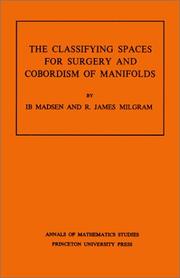
ISBN: 0691082251 069108226X 1400881471 Year: 1979 Publisher: Princeton, N. J.
Abstract | Keywords | Export | Availability | Bookmark
 Loading...
Loading...Choose an application
- Reference Manager
- EndNote
- RefWorks (Direct export to RefWorks)
Beginning with a general discussion of bordism, Professors Madsen and Milgram present the homotopy theory of the surgery classifying spaces and the classifying spaces for the various required bundle theories. The next part covers more recent work on the maps between these spaces and the properties of the PL and Top characteristic classes, and includes integrality theorems for topological and PL manifolds. Later chapters treat the integral cohomology of BPL and Btop. The authors conclude with a discussion of the PL and topological cobordism rings and a construction of the torsion-free generators.
Algebraic topology --- 515.16 --- Classifying spaces --- Cobordism theory --- Manifolds (Mathematics) --- Surgery (Topology) --- Differential topology --- Homotopy equivalences --- Topology --- Geometry, Differential --- Spaces, Classifying --- Fiber bundles (Mathematics) --- Fiber spaces (Mathematics) --- Topology of manifolds --- Classifying spaces. --- Cobordism theory. --- Manifolds (Mathematics). --- Surgery (Topology). --- 515.16 Topology of manifolds --- Bijection. --- Calculation. --- Characteristic class. --- Classification theorem. --- Classifying space. --- Closed manifold. --- Cobordism. --- Coefficient. --- Cohomology. --- Commutative diagram. --- Commutative property. --- Complex projective space. --- Connected sum. --- Corollary. --- Cup product. --- Diagram (category theory). --- Differentiable manifold. --- Disjoint union. --- Disk (mathematics). --- Effective method. --- Eilenberg–Moore spectral sequence. --- Elaboration. --- Equivalence class. --- Exact sequence. --- Exterior algebra. --- Fiber bundle. --- Fibration. --- Function composition. --- H-space. --- Homeomorphism. --- Homomorphism. --- Homotopy fiber. --- Homotopy group. --- Homotopy. --- Hopf algebra. --- Iterative method. --- Loop space. --- Manifold. --- Massey product. --- N-sphere. --- Normal bundle. --- Obstruction theory. --- Pairing. --- Permutation. --- Piecewise linear manifold. --- Piecewise linear. --- Polynomial. --- Prime number. --- Projective space. --- Sequence. --- Simply connected space. --- Special case. --- Spin structure. --- Steenrod algebra. --- Subset. --- Summation. --- Tensor product. --- Theorem. --- Topological group. --- Topological manifold. --- Topology. --- Total order. --- Variétés topologiques --- Topologie differentielle
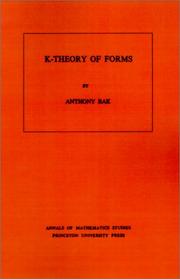
ISBN: 069108274X 0691082758 1400881412 9780691082752 9780691082745 Year: 1981 Volume: 98 Publisher: Princeton (N.J.): Princeton university press,
Abstract | Keywords | Export | Availability | Bookmark
 Loading...
Loading...Choose an application
- Reference Manager
- EndNote
- RefWorks (Direct export to RefWorks)
The description for this book, K-Theory of Forms. (AM-98), Volume 98, will be forthcoming.
Category theory. Homological algebra --- 515.14 --- Algebraic topology --- 515.14 Algebraic topology --- Forms (Mathematics) --- K-theory --- Modules (Algebra) --- Finite number systems --- Modular systems (Algebra) --- Algebra --- Finite groups --- Rings (Algebra) --- Homology theory --- Quantics --- Mathematics --- K-theory. --- Abelian group. --- Addition. --- Algebraic K-theory. --- Algebraic topology. --- Approximation. --- Arithmetic. --- Canonical map. --- Coefficient. --- Cokernel. --- Computation. --- Coprime integers. --- Coset. --- Direct limit. --- Direct product. --- Division ring. --- Elementary matrix. --- Exact sequence. --- Finite group. --- Finite ring. --- Free module. --- Functor. --- General linear group. --- Global field. --- Group homomorphism. --- Group ring. --- Homology (mathematics). --- Integer. --- Invertible matrix. --- Isomorphism class. --- Linear map. --- Local field. --- Matrix group. --- Maxima and minima. --- Mayer–Vietoris sequence. --- Module (mathematics). --- Monoid. --- Morphism. --- Natural transformation. --- Normal subgroup. --- P-group. --- Parameter. --- Power of two. --- Product category. --- Projective module. --- Quadratic form. --- Requirement. --- Ring of integers. --- Semisimple algebra. --- Sesquilinear form. --- Special case. --- Steinberg group (K-theory). --- Steinberg group. --- Subcategory. --- Subgroup. --- Subspace topology. --- Surjective function. --- Theorem. --- Theory. --- Topological group. --- Topological ring. --- Topology. --- Torsion subgroup. --- Triviality (mathematics). --- Unification (computer science). --- Unitary group. --- Witt group. --- K-théorie
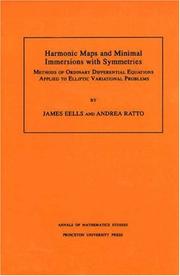
ISBN: 0691033218 069110249X 1400882508 9780691033211 9780691102498 Year: 1993 Volume: 130 Publisher: Princeton (N.J.): Princeton university press,
Abstract | Keywords | Export | Availability | Bookmark
 Loading...
Loading...Choose an application
- Reference Manager
- EndNote
- RefWorks (Direct export to RefWorks)
The aim of this book is to study harmonic maps, minimal and parallel mean curvature immersions in the presence of symmetry. In several instances, the latter permits reduction of the original elliptic variational problem to the qualitative study of certain ordinary differential equations: the authors' primary objective is to provide representative examples to illustrate these reduction methods and their associated analysis with geometric and topological applications. The material covered by the book displays a solid interplay involving geometry, analysis and topology: in particular, it includes a basic presentation of 1-cohomogeneous equivariant differential geometry and of the theory of harmonic maps between spheres.
Cartes harmoniques --- Harmonic maps --- Harmonische kaarten --- Immersies (Wiskunde) --- Immersions (Mathematics) --- Immersions (Mathématiques) --- Harmonic maps. --- Differential equations, Elliptic --- Applications harmoniques --- Immersions (Mathematiques) --- Équations différentielles elliptiques --- Numerical solutions. --- Solutions numériques --- Équations différentielles elliptiques --- Solutions numériques --- Differential equations [Elliptic] --- Numerical solutions --- Embeddings (Mathematics) --- Manifolds (Mathematics) --- Mappings (Mathematics) --- Maps, Harmonic --- Arc length. --- Catenary. --- Clifford algebra. --- Codimension. --- Coefficient. --- Compact space. --- Complex projective space. --- Connected sum. --- Constant curvature. --- Corollary. --- Covariant derivative. --- Curvature. --- Cylinder (geometry). --- Degeneracy (mathematics). --- Diagram (category theory). --- Differential equation. --- Differential geometry. --- Elliptic partial differential equation. --- Embedding. --- Energy functional. --- Equation. --- Existence theorem. --- Existential quantification. --- Fiber bundle. --- Gauss map. --- Geometry and topology. --- Geometry. --- Gravitational field. --- Harmonic map. --- Hyperbola. --- Hyperplane. --- Hypersphere. --- Hypersurface. --- Integer. --- Iterative method. --- Levi-Civita connection. --- Lie group. --- Mathematics. --- Maximum principle. --- Mean curvature. --- Normal (geometry). --- Numerical analysis. --- Open set. --- Ordinary differential equation. --- Parabola. --- Quadratic form. --- Sign (mathematics). --- Special case. --- Stiefel manifold. --- Submanifold. --- Suggestion. --- Surface of revolution. --- Symmetry. --- Tangent bundle. --- Theorem. --- Vector bundle. --- Vector space. --- Vertical tangent. --- Winding number. --- Differential equations, Elliptic - Numerical solutions
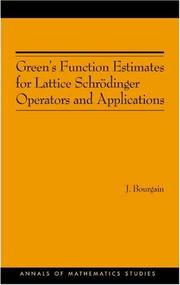
ISBN: 0691120978 1322075719 1400837146 0691120986 9780691120980 9781400837144 9780691120973 9781322075716 Year: 2005 Publisher: Princeton, N.J. Princeton University Press
Abstract | Keywords | Export | Availability | Bookmark
 Loading...
Loading...Choose an application
- Reference Manager
- EndNote
- RefWorks (Direct export to RefWorks)
This book presents an overview of recent developments in the area of localization for quasi-periodic lattice Schrödinger operators and the theory of quasi-periodicity in Hamiltonian evolution equations. The physical motivation of these models extends back to the works of Rudolph Peierls and Douglas R. Hofstadter, and the models themselves have been a focus of mathematical research for two decades. Jean Bourgain here sets forth the results and techniques that have been discovered in the last few years. He puts special emphasis on so-called "non-perturbative" methods and the important role of subharmonic function theory and semi-algebraic set methods. He describes various applications to the theory of differential equations and dynamical systems, in particular to the quantum kicked rotor and KAM theory for nonlinear Hamiltonian evolution equations. Intended primarily for graduate students and researchers in the general area of dynamical systems and mathematical physics, the book provides a coherent account of a large body of work that is presently scattered in the literature. It does so in a refreshingly contained manner that seeks to convey the present technological "state of the art."
Schrödinger operator. --- Green's functions. --- Hamiltonian systems. --- Evolution equations. --- Evolutionary equations --- Equations, Evolution --- Equations of evolution --- Hamiltonian dynamical systems --- Systems, Hamiltonian --- Functions, Green's --- Functions, Induction --- Functions, Source --- Green functions --- Induction functions --- Source functions --- Operator, Schrödinger --- Differential equations --- Differentiable dynamical systems --- Potential theory (Mathematics) --- Differential operators --- Quantum theory --- Schrödinger equation --- Almost Mathieu operator. --- Analytic function. --- Anderson localization. --- Betti number. --- Cartan's theorem. --- Chaos theory. --- Density of states. --- Dimension (vector space). --- Diophantine equation. --- Dynamical system. --- Equation. --- Existential quantification. --- Fundamental matrix (linear differential equation). --- Green's function. --- Hamiltonian system. --- Hermitian adjoint. --- Infimum and supremum. --- Iterative method. --- Jacobi operator. --- Linear equation. --- Linear map. --- Linearization. --- Monodromy matrix. --- Non-perturbative. --- Nonlinear system. --- Normal mode. --- Parameter space. --- Parameter. --- Parametrization. --- Partial differential equation. --- Periodic boundary conditions. --- Phase space. --- Phase transition. --- Polynomial. --- Renormalization. --- Self-adjoint. --- Semialgebraic set. --- Special case. --- Statistical significance. --- Subharmonic function. --- Summation. --- Theorem. --- Theory. --- Transfer matrix. --- Transversality (mathematics). --- Trigonometric functions. --- Trigonometric polynomial. --- Uniformization theorem.
Book
ISBN: 1282458000 1282936328 9786612936326 9786612458002 1400835399 9781400835393 9780691142920 0691142920 0691142939 9780691142937 9781282458000 9781282936324 Year: 2010 Publisher: Princeton : Princeton University Press,
Abstract | Keywords | Export | Availability | Bookmark
 Loading...
Loading...Choose an application
- Reference Manager
- EndNote
- RefWorks (Direct export to RefWorks)
This book studies the intersection cohomology of the Shimura varieties associated to unitary groups of any rank over Q. In general, these varieties are not compact. The intersection cohomology of the Shimura variety associated to a reductive group G carries commuting actions of the absolute Galois group of the reflex field and of the group G(Af) of finite adelic points of G. The second action can be studied on the set of complex points of the Shimura variety. In this book, Sophie Morel identifies the Galois action--at good places--on the G(Af)-isotypical components of the cohomology. Morel uses the method developed by Langlands, Ihara, and Kottwitz, which is to compare the Grothendieck-Lefschetz fixed point formula and the Arthur-Selberg trace formula. The first problem, that of applying the fixed point formula to the intersection cohomology, is geometric in nature and is the object of the first chapter, which builds on Morel's previous work. She then turns to the group-theoretical problem of comparing these results with the trace formula, when G is a unitary group over Q. Applications are then given. In particular, the Galois representation on a G(Af)-isotypical component of the cohomology is identified at almost all places, modulo a non-explicit multiplicity. Morel also gives some results on base change from unitary groups to general linear groups.
Shimura varieties. --- Homology theory. --- Cohomology theory --- Contrahomology theory --- Algebraic topology --- Varieties, Shimura --- Arithmetical algebraic geometry --- Accuracy and precision. --- Adjoint. --- Algebraic closure. --- Archimedean property. --- Automorphism. --- Base change map. --- Base change. --- Calculation. --- Clay Mathematics Institute. --- Coefficient. --- Compact element. --- Compact space. --- Comparison theorem. --- Conjecture. --- Connected space. --- Connectedness. --- Constant term. --- Corollary. --- Duality (mathematics). --- Existential quantification. --- Exterior algebra. --- Finite field. --- Finite set. --- Fundamental lemma (Langlands program). --- Galois group. --- General linear group. --- Haar measure. --- Hecke algebra. --- Homomorphism. --- L-function. --- Logarithm. --- Mathematical induction. --- Mathematician. --- Maximal compact subgroup. --- Maximal ideal. --- Morphism. --- Neighbourhood (mathematics). --- Open set. --- Parabolic induction. --- Permutation. --- Prime number. --- Ramanujan–Petersson conjecture. --- Reductive group. --- Ring (mathematics). --- Scientific notation. --- Shimura variety. --- Simply connected space. --- Special case. --- Sub"ient. --- Subalgebra. --- Subgroup. --- Symplectic group. --- Theorem. --- Trace formula. --- Unitary group. --- Weyl group.
Book
ISBN: 1400853079 9781400853076 Year: 2014 Publisher: Princeton Princeton University Press
Abstract | Keywords | Export | Availability | Bookmark
 Loading...
Loading...Choose an application
- Reference Manager
- EndNote
- RefWorks (Direct export to RefWorks)
Mathematical Notes, 29Originally published in 1983.The Princeton Legacy Library uses the latest print-on-demand technology to again make available previously out-of-print books from the distinguished backlist of Princeton University Press. These editions preserve the original texts of these important books while presenting them in durable paperback and hardcover editions. The goal of the Princeton Legacy Library is to vastly increase access to the rich scholarly heritage found in the thousands of books published by Princeton University Press since its founding in 1905.
Differential equations, Elliptic --- Schrödinger operator. --- Eigenfunctions. --- Functions, Proper --- Proper functions --- Boundary value problems --- Differential equations --- Integral equations --- Operator, Schrödinger --- Differential operators --- Quantum theory --- Schrödinger equation --- Numerical solutions. --- Numerical solutions --- Approximation. --- Ball (mathematics). --- Bounded function. --- Center of mass. --- Coefficient. --- Compact space. --- Complex number. --- Continuous function (set theory). --- Continuous function. --- Discrete spectrum. --- Distribution (mathematics). --- Eigenfunction. --- Eigenvalues and eigenvectors. --- Elliptic operator. --- Equation. --- Equivalence class. --- Essential spectrum. --- Estimation. --- Existential quantification. --- Exponential decay. --- Function space. --- Fundamental theorem of calculus. --- Geometry. --- Ground state. --- Infimum and supremum. --- Lebesgue measure. --- Open set. --- Pointwise. --- Quadratic form. --- Quantity. --- Restriction (mathematics). --- Riemannian manifold. --- Robert Langlands. --- Schrödinger equation. --- Self-adjoint operator. --- Self-adjoint. --- Smoothness. --- Special case. --- Subset. --- Support (mathematics). --- Theorem. --- Upper and lower bounds. --- Weak solution. --- Without loss of generality.
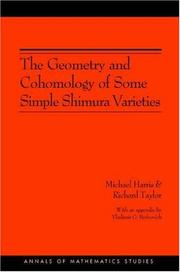
ISBN: 1400837200 9781400837205 0691090920 9780691090924 Year: 2001 Publisher: Princeton Princeton University Press
Abstract | Keywords | Export | Availability | Bookmark
 Loading...
Loading...Choose an application
- Reference Manager
- EndNote
- RefWorks (Direct export to RefWorks)
This book aims first to prove the local Langlands conjecture for GLn over a p-adic field and, second, to identify the action of the decomposition group at a prime of bad reduction on the l-adic cohomology of the "simple" Shimura varieties. These two problems go hand in hand. The results represent a major advance in algebraic number theory, finally proving the conjecture first proposed in Langlands's 1969 Washington lecture as a non-abelian generalization of local class field theory. The local Langlands conjecture for GLn(K), where K is a p-adic field, asserts the existence of a correspondence, with certain formal properties, relating n-dimensional representations of the Galois group of K with the representation theory of the locally compact group GLn(K). This book constructs a candidate for such a local Langlands correspondence on the vanishing cycles attached to the bad reduction over the integer ring of K of a certain family of Shimura varieties. And it proves that this is roughly compatible with the global Galois correspondence realized on the cohomology of the same Shimura varieties. The local Langlands conjecture is obtained as a corollary. Certain techniques developed in this book should extend to more general Shimura varieties, providing new instances of the local Langlands conjecture. Moreover, the geometry of the special fibers is strictly analogous to that of Shimura curves and can be expected to have applications to a variety of questions in number theory.
Mathematics --- Shimura varieties. --- MATHEMATICS / Number Theory. --- Varieties, Shimura --- Arithmetical algebraic geometry --- Math --- Science --- Abelian variety. --- Absolute value. --- Algebraic group. --- Algebraically closed field. --- Artinian. --- Automorphic form. --- Base change. --- Bijection. --- Canonical map. --- Codimension. --- Coefficient. --- Cohomology. --- Compactification (mathematics). --- Conjecture. --- Corollary. --- Dimension (vector space). --- Dimension. --- Direct limit. --- Division algebra. --- Eigenvalues and eigenvectors. --- Elliptic curve. --- Embedding. --- Equivalence class. --- Equivalence of categories. --- Existence theorem. --- Field of fractions. --- Finite field. --- Function field. --- Functor. --- Galois cohomology. --- Galois group. --- Generic point. --- Geometry. --- Hasse invariant. --- Infinitesimal character. --- Integer. --- Inverse system. --- Isomorphism class. --- Lie algebra. --- Local class field theory. --- Maximal torus. --- Modular curve. --- Moduli space. --- Monic polynomial. --- P-adic number. --- Prime number. --- Profinite group. --- Residue field. --- Ring of integers. --- Separable extension. --- Sheaf (mathematics). --- Shimura variety. --- Simple group. --- Special case. --- Spectral sequence. --- Square root. --- Subset. --- Tate module. --- Theorem. --- Transcendence degree. --- Unitary group. --- Valuative criterion. --- Variable (mathematics). --- Vector space. --- Weil group. --- Weil pairing. --- Zariski topology.
Book
ISBN: 0691189633 Year: 2019 Publisher: Princeton, NJ : Princeton University Press,
Abstract | Keywords | Export | Availability | Bookmark
 Loading...
Loading...Choose an application
- Reference Manager
- EndNote
- RefWorks (Direct export to RefWorks)
This book presents the complete proof of the Bloch-Kato conjecture and several related conjectures of Beilinson and Lichtenbaum in algebraic geometry. Brought together here for the first time, these conjectures describe the structure of étale cohomology and its relation to motivic cohomology and Chow groups.Although the proof relies on the work of several people, it is credited primarily to Vladimir Voevodsky. The authors draw on a multitude of published and unpublished sources to explain the large-scale structure of Voevodsky's proof and introduce the key figures behind its development. They go on to describe the highly innovative geometric constructions of Markus Rost, including the construction of norm varieties, which play a crucial role in the proof. The book then addresses symmetric powers of motives and motivic cohomology operations.Comprehensive and self-contained, The Norm Residue Theorem in Motivic Cohomology unites various components of the proof that until now were scattered across many sources of varying accessibility, often with differing hypotheses, definitions, and language.
Homology theory. --- Cohomology theory --- Contrahomology theory --- Algebraic topology --- 5P. --- Abelian group. --- Addition. --- Additive category. --- Adjoint functors. --- Alexander Grothendieck. --- Algebraic closure. --- Algebraic cobordism. --- Algebraic cycle. --- Algebraic extension. --- Algebraic geometry. --- Algebraic topology. --- Andrei Suslin. --- Axiom. --- Characteristic class. --- Classifying space. --- Closed set. --- Codimension. --- Cofibration. --- Cohomology operation. --- Cohomology. --- Conjecture. --- Corollary. --- Diagram (category theory). --- Direct limit. --- Exact sequence. --- Factorization. --- Fibration. --- Functor. --- Galois cohomology. --- Galois extension. --- Group object. --- Homology (mathematics). --- Homotopy category. --- Homotopy. --- Hypersurface. --- Inverse function. --- Mathematical induction. --- Mathematics. --- Milnor K-theory. --- Model category. --- Module (mathematics). --- Monoid. --- Monomorphism. --- Morphism. --- Motivic cohomology. --- Natural number. --- Normal bundle. --- Open set. --- Presheaf (category theory). --- Pushout (category theory). --- Quantity. --- Quillen adjunction. --- Rational point. --- Regular representation. --- Remainder. --- Retract. --- Separable extension. --- Sheaf (mathematics). --- Smooth scheme. --- Special case. --- Subgroup. --- Summation. --- Tangent space. --- Theorem. --- Trivial representation. --- Vladimir Voevodsky. --- Weak equivalence (homotopy theory).
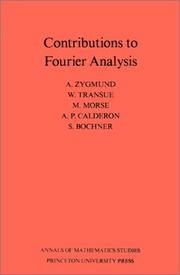
ISBN: 0691079307 1400881951 Year: 1950 Publisher: Princeton University Press
Abstract | Keywords | Export | Availability | Bookmark
 Loading...
Loading...Choose an application
- Reference Manager
- EndNote
- RefWorks (Direct export to RefWorks)
The description for this book, Contributions to Fourier Analysis. (AM-25), will be forthcoming.
Fourier analysis. --- Analysis, Fourier --- Mathematical analysis --- Absolute value. --- Almost periodic function. --- Approximation. --- Bessel function. --- Bilinear map. --- Boundary value problem. --- Characterization (mathematics). --- Coefficient. --- Compact space. --- Comparison theorem. --- Conservative vector field. --- Constant function. --- Continuous function. --- Corollary. --- Counterexample. --- Diagonalization. --- Diagram (category theory). --- Diameter. --- Dimension. --- Dirichlet kernel. --- Dirichlet problem. --- Dirichlet's principle. --- Distribution function. --- Exponential polynomial. --- Exponential sum. --- Fourier series. --- Fourier transform. --- Harmonic function. --- Hilbert space. --- Hölder's inequality. --- Integer. --- Interpolation theorem. --- Linear combination. --- Lp space. --- Measurable function. --- Measure (mathematics). --- Partial derivative. --- Partial differential equation. --- Periodic function. --- Poisson formula. --- Polynomial. --- Power series. --- Quantity. --- Rectangle. --- Remainder. --- Semicircle. --- Several complex variables. --- Sign (mathematics). --- Simple function. --- Special case. --- Sphere. --- Square root. --- Step function. --- Subsequence. --- Subset. --- Theorem. --- Theory. --- Triangle inequality. --- Two-dimensional space. --- Uniform continuity. --- Uniform convergence. --- Variable (mathematics). --- Vector field. --- Vector space.
| Listing 1 - 10 of 112 | << page >> |
Sort by
|

 Search
Search Feedback
Feedback About UniCat
About UniCat  Help
Help News
News